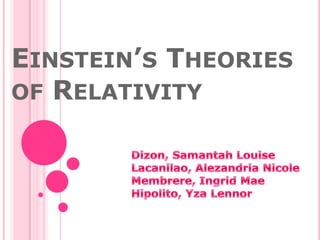
natsci1report (2007version)
- 1. Einstein’s Theories of Relativity Dizon, Samantah Louise Lacanilao, Alezandria Nicole Membrere, Ingrid Mae Hipolito, YzaLennor
- 2. Special Theory of Relativity It was published in 1905. It deals with problems involving inertial frames of reference (frames moving at constant velocity) with respect to each other. General Theory of Relativity It was published in 1915. It deals with problems involving accelerated reference frames.
- 3. The Search for the Ether: The Michelson-Morley Experiment
- 4. What is Ether? It was believed to occupy all cosmos. It is undetectable by ordinary means. It was supposed to permeate all matter and space. It was supposedly a medium to act as a carrier of waves, including light.
- 5. The Michelson Interferometer (c)RiA
- 6. Results of the Experiment The results were negative, even after repeating it six years later.
- 7. Hypotheses for the Results The ether was not stationary but was dragged along with the earth. The earth was fixed in the ether and everything else in the universe moved with respect to the earth and the ether. The velocity of light was always at constant with respect to the source which emitted it. Ether did not exist at all.
- 8. Postulates of Special Theory of Relativity
- 9. Postulate 1: The speed of light is independent of the motion of the Light of source or receiver. This postulate concerns the constancy of the speed of light to all observers. All measurements, whether stationary or moving observers relative to a moving or stationary source always give the same value for the speed of light, c=3x10 m/s. This postulated is supported by the results of the Michelson-Morley Experiments. 8
- 10. Postulate 2: All inertial frames are equivalent with respect to all laws of physics This postulate concerns “relativeness” of reference frames (principle of relativity). It follows directly from the absence of a universal frame of reference. A place moving with constant velocity are the same as those in a stationary place.
- 11. Herman Bondi labelled the 2 postulates respectively: Uniqueness of light –the speed of light is the same for all observers whether moving or not. The speed of light is an invariant. Irrelevance of Velocity –there is no absolute reference frame. All frames are equivalent with respect to the laws of physics.
- 12. Space, Time, Mass and Energy according to Einstein
- 13. Length/Space Contraction The length of an object is maximum when measured in a frame which is at rest; the length is minimum when measured in a moving reference frame. L = L √1 – v / c _______ 2 2 0
- 14. Time Dilation Time is affected by relative motion. Time runs slower in a moving reference frame than in a stationary frame. t’ = t √ 1 – v / c _______ _______ 2 2
- 15. Relativity of Mass Classical physics regard mass as constant, but mass according to relativity is also dependent on motion. Therefore, the mass of a body changes as the body is set into motion. m = m √ 1 – v / c *Nothing can exceed the speed of light; it is the limit to which moving objects can approach. _______ _______ 0 2 2
- 16. Equivalence of Mass and Energy Mass is a form of energy. E = mc shows that 1kg of mass = 9 X 10 J Significance of the Special Theory of Relativity: 1.) Effect of Newtonian Mechanics 2.) The practical use of relativity is in atomic and nuclear physics. 3.) Philosophical impact on the course of physical theory. 4.) The idea of ether had to be discarded. 2 16
- 17. Experimental results that support the Special theory of Relativity: 1.) Radioactive Particle Experiments 2.) Elementary Particle Experiments 3.) The Cockroft and Walton Experiment
- 18. The General Theory of Relativity
- 19. Einstein published the General Theory of Relativity which was an attempt to account for the properties of motion in accelerated and noninertial frames of reference. The basis of this theory is the Principle of Equivalence: A homogeneous gravitational field is completely equivalent to a uniformly accelerated reference frame.
- 20. Four-Dimensional Space Time; Consequences of The General Theory of Relativity
- 21. Space and are dynamic quantities. Space-time is flat in free space. Space-time is curved or warped near gravitational fields. Objects that follow the shortest path between two points in a curved space (Geodesics). Gravity is a consequence of the fact that space-time is curved. Light rays also follow geodesics. Light is bent by gravitational fields. Outstanding Consequences of the General Theory of Relativity
- 22. The principle of equivalence is the deflection of a light beam in a gravitational field. Light will accelerate (hence, it is deflected) in a gravitational field. Other consequences